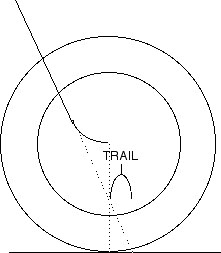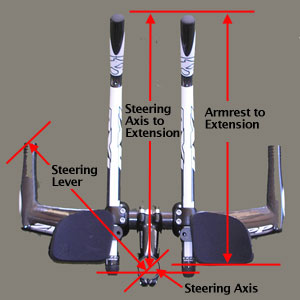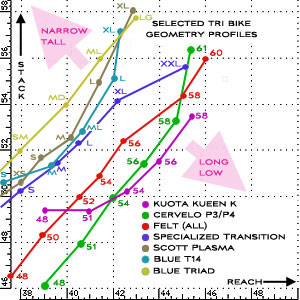Steering geometry for tri bikes
This subject had been covered to my reasonable satisfaction in a comprehensive article on bike geometry. I have also tweaked the subject a bit more in a geometrical experiment in which I engaged over the past couple of years. Nevertheless I thought I'd revisit the issue and attempt to amalgamate everything, especially in light of new USAT bike rules allow my "experiment" to be engaged in by anyone of any height without fear of disqualification.
FORCES AFFECTING STEERING AND HANDLING
Let me begin by stating the following: the sum of facts I know is greater than the degree of understanding I possess. It's one thing to comprehend concepts like trail and steering axis and gyroscopic forces, another thing altogether to know with precision how a bicycle is going to handle once a design is executed in the form of a road-ready machine. That established, here goes.
There are quite a few forces that affect a bicycle's steering and handling. Fortunately, these forces usually tend to work in concert with each other, or at least can be made to. One force I almost never hear mentioned is the gyroscopic effect exerted on the bicycle as a result of its spinning wheels. Why is it relatively easy to ride a bicycle with no hands at a reasonable speed, but difficult at low speeds? Your bicycle's wheels do what all gyroscopes do, that is, the faster they spin the more they want to stay true to their various axis planes.
Up to a point, that is. If you execute a change across the axis of a gyroscope, it'll affect another axis. If you tilt a spinning wheel—imagine riding no-hands and banking into a turn, that is, without actually turning the wheel—the gyroscopic forces at work in the wheel will cause it to turn in the same direction. In other words, if while riding with no hands you bank to the left, the wheel will also turn to the left. This is an example of precession. The wheel will precess in this axis because of a change applied to another axis.
This is not the only reason the wheel turns left as the bike and rider's combined center of gravity falls to the left of the bike's centerline. We'll get to that. As we leave the subject of gyroscopes, I don't want you to minimize its effect on bike handling. The reason you can't ride a bike with no hands at 4 miles per hour, but you can at 15 miles per hour, is mostly due to the gyroscopic nature of your bike's wheels.
TRAIL, RAKE AND FRONT-END STABILITY
These gyroscopic forces are one reason you're able to ride a bike. There is one additional self-centering tactic employed in bike design, and that is the placement of your wheel's contact patch behind the steering axis.

Bikes have "trail" when the front wheel’s contact patch—the place where the rubber literally meets the road—falls behind the point where the bike's steering axis would (theoretically) meet the road. The further the contact patch falls behind the steering axis, the more trail there is and the more likely the bike will want to go in a straight line. The degree of the bike's determination to steer in a straight line equates to it's "sluggishness" as well as it's "stability," just different sides of the same coin.
You’ll notice two circles in the diagram, and they illustrate that wheelsize does matter in the equation. A 650c wheel will have less trail than a 700c wheel if the bike is made with the same head angle and fork offset. Therefore, a 650c-wheel bike ought to have a little less offset, or a slightly shallower head angle, to account for the difference in wheel radius. Reducing offset is often easily accomplished by just hacking a bit of fork rake off a 700c fork, and this is the way many fork companies make their 650c forks.
But wait, there's more! As noted a few paragraphs above, there is a bit less angular momentum in a 650c wheel (even when it's spinning slightly faster to achieve a velocity equal to a bike with a 700c front wheel). Therefore, you need to compensate for this lack of a gyroscopic effect, and stick a little bit of extra trail into the bike.
At this point I suppose I'd better stop for some definitions. Notice in the picture above there's a forward arc to the fork blade just before it terminates at the point your front wheel affixes to it. This is variably called "rake" and "offset." Most people agree that "offset" can be described as the amount your wheel axle deviates, or is "offset," from the steering axis. In other words, if your fork blades didn't do that little forward juke, you'd have no offset.
Be not deceived, however, as to the various ways offset can be achieved. Fork blades can be entirely straight and still be offset from the bike's steering axis. If the blades leave the fork crown at a flatter angle than that fork's steer column, then your fork's dropouts are going to be placed in a position offset from the steering axis.
Anyway, here's the thing. As you might be able to determine from the diagram, as there is more and more forward arc in the fork's blades (that is, as there is more and more offset), you'll notice there is less and less trail. What does this mean? Just keep this in mind: The farther the tire contacts the ground behind the steering axis—the more "trail" your bike has—the more your wheel is going to want to self-center. In other words, less offset will give you more trail, yielding a more stable bike, or a more sluggish bike, depending on your point of view. Adding more and more offset gives you less and less trail. This means your bike is going to handle more quickly, with less tendency toward staying true to the bike's forward direction.
This might seem funny to you, because you've noticed that cruiser bikes and touring bikes tend toward having a lot of forward arc (offset) in their forks. Yes, but they also have slacker head angles, which also increases trail. So in this case slackening the head angle from, say, 73 to 72 degrees balances out adding, oh, 5mm of offset. In so doing you've kept the trail the same, but you've added to the bike's wheelbase, giving you another element of stability.
Here's one other issue, however. Yes, more trail means less offset, which in turn means more stability. But this is true at relatively higher speeds. At very low speeds—a few miles an hour—a bike is actually easier to control with less trail. So, perhaps some of these cruisers are intentially made to be ridden with less trail, as they are ridden at slow speeds.
While "trail" and "offset" are commonly agreed upon terms, "rake" is used in any number of ways. It's common for the bike industry to use "rake" and "offset" synonymously. Yet in the motorcycle industry "rake" never means "offset," and rake is almost always considered an angular measure. Often, motorcycle articles call "rake angle" what we in the bicycle world call "head angle." Some bicycle authors use this term as well, but when they do it's confusing to the rest of us.
So, then, you've got two things working in your favor, as you endeavor to keep the tires glued to the road and your body perched above it: the gyroscopic effects of wheels, and the degree to which the contact patch of your front tire "trails" the theoretical point where your steering axis would contact the ground. But don't think that more trail is always a good thing. It is good only up to a point. What is that point? In the neighborhood of 6cm. More than a centimeter in either direction is usually considered undesirable (if you're talking only about standard bicycles; once you expand the discussion to recumbants, or motorcycles, ideas about trail values change).
If trail is a good thing, why isn't more trail more of a good thing? To understand this you need to understand how a bike is steered, and how a tri bike is steered. You don’t steer a bike—any bike—by turning in the direction you want to go. You first countersteer, that is, you turn the wheel in the opposite direction. You may not realize this until you’re next to a curb, or next to another rider, from which you must veer away. You then realize you have no room to maneuver, and that’s because the first maneuver is to veer away from the desired direction in order to get your center of gravity between the bike and the direction you want to go. Then you can lean into the turn.
The reason this is important to know is that a tri bike can be a big ship to turn (when you're in the aero position) if it’s a slow handler. It takes longer to countersteer a tri bike when your elbows are in the cups, and that’s why you can’t have a bike under you that handles sluggishly. Trail is good, but too much trail means the bike won’t want to turn at all.
WEIGHT DISPLACEMENT
Tri bikes have a further problem to consider. A triathlete’s weight is positioned over the front of the bike when he’s in the aero position. Worse yet, if he's riding a steep seat angle even more of his weight is transfered forward. Even when he’s not laid out on the tri bars the weight is still forward because of the steep seat angle. The trick is to both shallow the head angle and increase the rake, in which case the trail will remain roughly the same, but the bike’s front/center (and therefore its wheelbase) will increase dramatically. This will help in getting the weight displaced over the bike more evenly.
You might wonder, then, why tri bikes have head angles and fork rakes roughly similar to road race bikes. Because tri bike makers haven’t figured out yet that they have the ability to make a much better handling bike by abandoning traditional modes of front-end bike design. Also, many or most aftermarket fork makers haven’t yet made many forks with more than 45mm of offset. In the fork makers' defense, however, they haven’t yet been asked by the bike makers to make aero forks with this much offset.
Just the same, expect to eventually see a lot of tri bikes with 71 and 72 degree head angles, paired with forks that have between 45mm and 50mm of rake. These bikes would handle well, and be much better on turns and descents. They'd also offer a plusher ride.
But, they'll have a ton of wheelbase, and this causes certain inconveniences. A lot of wheelbase is great for descents. But it's not such a red hot feature when you're going up the mountain, specifically when you're out of the saddle. Lots of wheelbase creates the impression you're dragging the bike around behind you when you're standing. This is an annoyance you'll have to weigh when considering adding wheelbase to your idea of a bike. My tri bike has 107cm of wheelbase, compared to just over 100cm on my road race bike. My tri bike is stable as hell on descents, and the ride is plush. But, climbing a long climb on the tri bike is awkward (I tend to stand a lot when I climb).
One did not used to be able to ride these long wheelbase bikes legally in triathlons, however a rule change instituted this year allows taller people, like me (6'2") to ride steep seat angle tri bikes with what I feel is safer, stabler geometry. The new front/center rule allows the front center to be as much as 7/8 of a rider's saddle height (bottom bracket to top of saddle).
What can the triathlete take away from all this? First, that a tri bike ought not to simply point itself in a straight line, it needs to have a little sprightliness. Second, that by virtue of its short chainstay, short top tube, steep seat angle, and weight bearing aero bars—all of which force the rider's weight forward and over the front wheel—bike makers ought to compensate by lengthening their front/center dimensions, with fork-makers aiding the process by making aero forks to match. We haven't yet seen that to that to any great degree.
"I ride a retrofitted road bike right now, with tons of weight on the front wheel, and I haven't crashed." Yes, you might say that. However, the need for better weight distribution pays dividends twice. First, in terms of safety. And oddly enough, not when you're in the aero position, but when you're out of it. A steep seat angle bike will have more weight on the front wheel both when you're in the aero bars, but also when you're out of the aero bars and with your hands on the pursuits; second, the amount of weight on the front wheel increases as the descent steepens, and increases even more as you brake. So, you might feel quite safe with your weight over the front wheel while riding along the flats, it's when you're sitting up with your hands on the pursuit bars, while descending, cornering and braking, that weight distrubition becomes an issue.
Additionally, even if you don't care about the safety issue, it's just plain faster when you have your weight more over your driving wheel.
MANIPULATING TOP TUBE, HEAD ANGLE, OFFSET
Finally, here's a question you might wonder. Let us say that you knew you wanted 5.7cm of trail, and 65cm of front/center (bottom bracket to front axle) and 102cm of wheelbase, and that you needed a certain cockpit distance, that is, a specific distance from the nose of the saddle to the armrests. The bright observer might note that there is an infinite way to achieve all these things. Instead of, say, 55cm of top tube and 11cm of stem on a bike with a 73 degree head tube and a fork with 43mm of offset, one might choose a 74 degree head tube. In this case, to keep 5.7cm of trail you'd need a fork with 37mm of offset.
Again, let's assume you want to keep your wheelbase and front/center the same, because there's a certain weight displacement you want to achieve (you don't want too much weight on the front wheel). This necessarily means your bike is going to have a longer top tube, but, no worries, you can reduce the stem length by the same amount and, presto, you have (on paper) the exact same dimensions, same weight displacement, and the same amount of trail, so, theoretically, the same basic riding characteristics.
So, what's better? More top tube, shorter stem, steeper head angle? Or a slacker head angle, but everything else basically the same? Frankly, I don't know for sure from experience, that is, I don't have a large enough sample set to be able to speak with confidence. However, I have some suspicions.
As you shorten the stem, the distance between your hands and the steering axis shortens as well. The "tiller," if you will, becomes shorter. Therefore, it takes less movement to effect a turn. At the same time, it requires a slight bit more force to execute a turn. As you progressively shorten the stem this tendency becomes more pronounced. No big deal, you might say. It's not that hard to turn a bike. It doesn't take that much muscular effort.
But it does. When you consider all the movements you must make on a bike to keep it tracking in a straight line, the further you ride the more they add up. But there is a more pressing argument for the longer stem. What happens when you find yourself in trouble? A dicey steering emergency, or combating a high speed wobble? This is when precise steering and/or the ability to fight through a wobble becomes important. Here is when the longer stem can be an ally.
These are steering issues. The slacker angle, coupled with greater offset, also give you a couple of unrelated but important assets. Chief among them is suspension, especially nice in a tri bike. A straighter, steeper fork has no good capacity for vertical compliance, but the slacker one's head angle and the greater the offset, the more compliance a bike exhibits.
As I roll my spare change and trade it in for paper dollars at the bank, I'll be able to afford more front-end experiments, which necessarily mean entirely new frames and forks. As they are built and ridden I'll be back with updates to the tri bike steering knowledge base.




Start the discussion at slowtwitch.northend.network